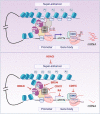Targeting MYCN in Pediatric and Adult Cancers
- PMID: 33628735
- PMCID: PMC7898977
- DOI: 10.3389/fonc.2020.623679
Targeting MYCN in Pediatric and Adult Cancers
Abstract
The deregulation of the MYC family of oncogenes, including c-MYC, MYCN and MYCL occurs in many types of cancers, and is frequently associated with a poor prognosis. The majority of functional studies have focused on c-MYC due to its broad expression profile in human cancers. The existence of highly conserved functional domains between MYCN and c-MYC suggests that MYCN participates in similar activities. MYC encodes a basic helix-loop-helix-leucine zipper (bHLH-LZ) transcription factor (TF) whose central oncogenic role in many human cancers makes it a highly desirable therapeutic target. Historically, as a TF, MYC has been regarded as "undruggable". Thus, recent efforts focus on investigating methods to indirectly target MYC to achieve anti-tumor effects. This review will primarily summarize the recent progress in understanding the function of MYCN. It will explore efforts at targeting MYCN, including strategies aimed at suppression of MYCN transcription, destabilization of MYCN protein, inhibition of MYCN transcriptional activity, repression of MYCN targets and utilization of MYCN overexpression dependent synthetic lethality.
Keywords: MYC; MYCN; Super-enhancer (SE); cancer; cofactor; pediatric cancer; transcription factor.
Copyright © 2021 Liu, Chen, Clarke, Veschi and Thiele.
Conflict of interest statement
The authors declare that the research was conducted in the absence of any commercial or financial relationships that could be construed as a potential conflict of interest.
Figures





Similar articles
-
Molecular Mechanisms of MYCN Dysregulation in Cancers.Front Oncol. 2021 Feb 3;10:625332. doi: 10.3389/fonc.2020.625332. eCollection 2020. Front Oncol. 2021. PMID: 33614505 Free PMC article. Review.
-
Demystifying the Druggability of the MYC Family of Oncogenes.J Am Chem Soc. 2023 Feb 15;145(6):3259-3269. doi: 10.1021/jacs.2c12732. Epub 2023 Feb 3. J Am Chem Soc. 2023. PMID: 36734615 Free PMC article. Review.
-
Targeting oncogenic Myc as a strategy for cancer treatment.Signal Transduct Target Ther. 2018 Feb 23;3:5. doi: 10.1038/s41392-018-0008-7. eCollection 2018. Signal Transduct Target Ther. 2018. PMID: 29527331 Free PMC article. Review.
-
Combined IFN-gamma and retinoic acid treatment targets the N-Myc/Max/Mad1 network resulting in repression of N-Myc target genes in MYCN-amplified neuroblastoma cells.Mol Cancer Ther. 2007 Oct;6(10):2634-41. doi: 10.1158/1535-7163.MCT-06-0492. Mol Cancer Ther. 2007. PMID: 17938259
-
MYCN-mediated transcriptional repression in neuroblastoma: the other side of the coin.Front Oncol. 2013 Mar 11;3:42. doi: 10.3389/fonc.2013.00042. eCollection 2013. Front Oncol. 2013. PMID: 23482921 Free PMC article.
Cited by
-
Therapeutic Targeting of Exportin-1 in Childhood Cancer.Cancers (Basel). 2021 Dec 7;13(24):6161. doi: 10.3390/cancers13246161. Cancers (Basel). 2021. PMID: 34944778 Free PMC article. Review.
-
The long journey to bring a Myc inhibitor to the clinic.J Cell Biol. 2021 Aug 2;220(8):e202103090. doi: 10.1083/jcb.202103090. Epub 2021 Jun 23. J Cell Biol. 2021. PMID: 34160558 Free PMC article. Review.
-
Identification of key genes and signaling pathways of liver cancer and model construction for prognosis and diagnosis based on bioinformatics analysis.PLoS One. 2025 Jun 4;20(6):e0325610. doi: 10.1371/journal.pone.0325610. eCollection 2025. PLoS One. 2025. PMID: 40465781 Free PMC article.
-
Contribution of Microhomology to Genome Instability: Connection between DNA Repair and Replication Stress.Int J Mol Sci. 2022 Oct 26;23(21):12937. doi: 10.3390/ijms232112937. Int J Mol Sci. 2022. PMID: 36361724 Free PMC article. Review.
-
Inhibition of PI3 kinase isoform p110α suppresses neuroblastoma growth and induces the reduction of Anaplastic Lymphoma Kinase.Cell Biosci. 2022 Dec 30;12(1):210. doi: 10.1186/s13578-022-00946-9. Cell Biosci. 2022. PMID: 36585695 Free PMC article.
References
Publication types
LinkOut - more resources
Full Text Sources
Other Literature Sources
Miscellaneous

